Each day, over a million people from around the globe seek to enter the U.S. through one of about 317 designated "ports-of-entry". Many enter by land, such as at entry stations near San Diego or Detroit. Others enter at international airports, such as JFK in New York or O'Hare in Chicago, or through seaports in Miami or elsewhere.
|
|
The general process of entry into the U.S.
In government lingo, people who arrive at a US port of entry must be "inspected" and "admitted" before being allowed to enter. This requirement applies to everyone, including US citizens. The government reports that it conducted over 417 million inspections in F Y 2005, or over 1.1 million per day. Of these, less than one-tenth of one percent were refused entry. See Figure 1 and supporting table.
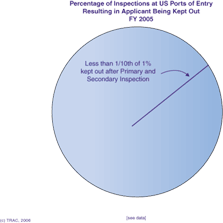
Figure 1. Click for larger image |
US citizens made up 40% of all arrivals last year. Broadly speaking, two types of travelers accounted for the other 60%. "Immigrant s" are not citizens but have permission to live permanently in the U.S., such as those with green cards. "Non-immigrants" have been previously cleared for temporary stays in the country. Non-immigrants include students, tourists, and officials of foreign governm ents. Non-citizens, both Immigrants and Non-immigrants, are classified as Aliens. See Figure 2 and supporting table.
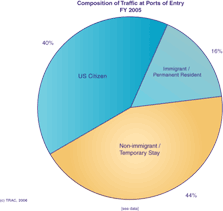
Figure 2. Click for larger image |
When travelers arrive at a US port of entry, they first encounter Immigration Officers, also known as Inspectors. Citizens present their US passports to these officers; aliens usually present their foreign passport and visa or other entry document.
The role of government Inspectors
Typically, Immigration Officers are the officials who make most of the decisions about who is allowed to enter and who is kept out. The process by which these decisions are made is depicted graphically in Figure 3 and described below (also see supporting table).
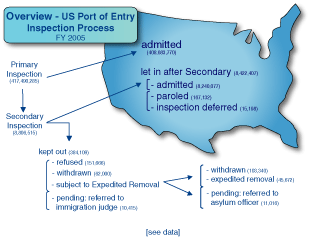
Figure 3. Click for larger image |
In a procedure known as Primary Inspections, the officers interview people appearing before them and check their documents. In addition, the documents are scanned into a computer to detect past immigration violations, criminal problems, and national security concerns. The entire process is very brief, averaging less than one minute per person to keep up with the crush of arriving travelers. Inspectors, then, have to make split-second decisions throughout their work day. Do they suspect that someone's documents are bogus? Do they think there might be some legal barriers to entry based on health or economic grounds? Do they have any reason to doubt that the person wanting to come into the country is who they say they are?
Last year, Inspectors in Primary had no such suspicions about 98% of all people they encountered; they let them in. They sent the other 2% - just under 9 million - into a process known as Secondary Inspections. See Figure 4 and supporting table.
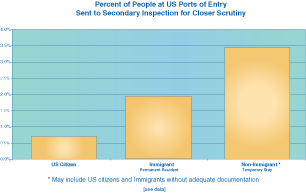
Figure 4. Click for larger image |
Temporary permission to enter the U.S.
One option for Inspectors in Secondary is to let someone in temporarily through a process called "parole". Immigration laws specify that this can be done for "humanitarian" reasons such as to obtain medical treatment in the U.S., or for "public benefit" reasons, such as to testify in court proceedings. It is also available to persons already living in the U.S. whose immigration status does not allow them normally to leave and re-enter. Persons seeking to enter through parole have usually applied for this status - and been approved – prior to coming to a port of entry. 167,132 persons were "paroled" last year.
Inspectors are even empowered to let in some travelers who don't have all of the required paperwork with them. If the officers feel that the travelers can eventually come up with the necessary evidence, are not in blatant violation of immigration laws, and pose no security risk, they can give them a date and time in the future to come to an immigration office for a final determination at that time. 15,198 persons were granted such "Deferred Inspection" last year.
Eventually, most people who end up in Secondary are allowed to enter the country. In FY 2005, only 384,109 people were kept out or faced more processing. See Figure 5 and accompanying table.
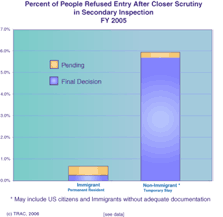
Figure 5. Click for larger image |
Who is kept out?
In many instances, a person seeking to enter the U.S. may present valid documents but still not be eligible to come in. Someone traveling on a tourist visa, for instance, may indicate a plan to work or study in the U.S. "through ignorance of permissible activities". When such innocent intentions come to light, Inspectors may simply "refuse" the application to enter or allow travelers to withdraw the application. Such a result allows these persons to avoid a long waiting period before they can attempt to come to the U.S. again. In FY 2005, 213,666 persons found themselves in this situation.
Sometimes, Inspectors encounter individuals who claim to be a citizen, green card holder, refugee, or have been granted asylum but do not have documents to prove their status. If no records can be found in government databases to verify it, Inspectors must refer them to an Immigration Judge for a court hearing. This occurred 10,415 times in FY 2005. If their claim to such legal status is rejected by the judge, they can be legally removed from the country.
Expedited removal process
A recurring issue that Inspectors face is what to do with persons who clearly should not be allowed in due to their lack of proper entry documents. Prior to 1996, immigration inspectors could not compel someone to depart, but could only refer them to an immigration judge for a hearing. Now, where evidence suggests that the travelers are blatantly violating the law, such as by presenting fraudulent papers, Inspectors are instructed to issue an "Expedited Removal" order against them. Expedited Removals were authorized by Congress to get tough on egregious violators of entry laws by sending them back out of the country as quickly as possible with a record in their immigration file that prevents them from returning for five years. For many Mexicans arriving overland at ports of entry on the southern border, or Canadians on the northern border, this means turning them around back to Mexico or Canada immediately. For citizens of other countries, the process of removing them takes more time. Those arriving by airplane are held until a seat is available on a returning flight. 45,672 such orders were issued last year.
Because of the severity of expedited removal orders, Inspectors are instructed that they must first be convinced that persons are blatantly violating the law. Inspectors may allow persons to merely withdraw their request to enter the U.S., thus avoiding an actual order. This may occur where the lack of documents resulted from "inadvertent error, misinformation, or where no fraud was intended", such as where a visa has expired. In FY 2005, the majority – about 65% of those subject to Expedited Removal - were allowed this avenue.
|
FY 2005
|
The process of identifying legitimate asylum seekers is understandably difficult given the limited time for inspection and the large number of travelers who must be processed. So, not surprisingly, at least one government study [1] has criticized inspections for, among other problems, not identifying all asylum seekers and, instead, returning some to countries where they may face torture and even death.
Criminal and Other Activity Uncovered |
Discoveries During Inspection Process
Although the vast majority of inspections result in the applicant being allowed to enter the United States, Immigration Officers also uncover evidence of criminal activity. The activity ranges from possession of fraudulent documents to the smuggling of aliens and narcotics (see table).
Additionally, inspectors come across aliens with prior convictions who are now inadmissible, or who for other reasons authorities wish to detain.
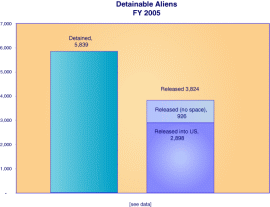
Figure 6. Click for larger image |
Detainable Aliens
In FY 2005, 9,663 aliens were judged detainable. Of these, 3,824 - almost 40% - were released instead of being held -- and almost 10% were released because there was not room to hold them. See Figure 6 and supporting table.
[1] Report on Asylum Seekers in Expedited Removal, A Study Authorized by Section 605 of the International Religious Freedom Act of 1998, The United States Commission on International Religious Freedom, February 8, 2005.